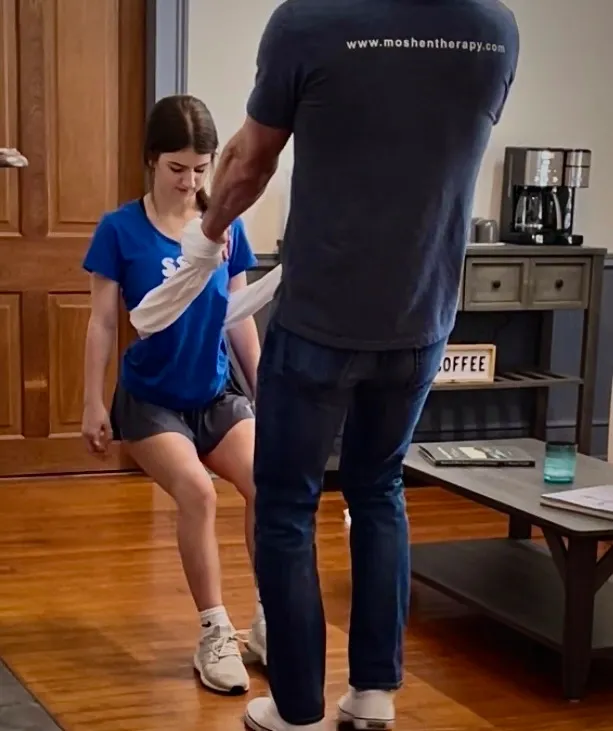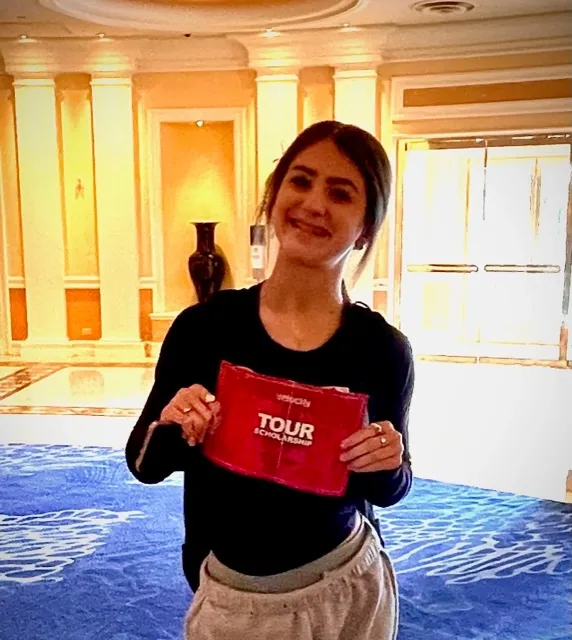I sat down with a former patient to discuss her experience overcoming adversity and competing at the highest level.

CD: You are on two very good competitive dance teams. For people who aren’t in the dance world and might not understand what that’s like, describe what a typical day looks like for you.
HG: A typical weekday would look like going to school for the first 6-7 hours of the day. Then, depending on which day, going to dance team practice for the school for a couple of hours, doing homework, then going to the studio to work with the studio company where we would do things like strengthening, conditioning, stretching, and rehearsing choreography for competition until about 9 or 9:30 at night.
CD: Typically, competitive dance takes place over a season. Can you describe how that process works?
HG: For us, every year starts in August. You have summer classes that are mandatory to audition for the Pro Company at the studio. The first three days is usually “refined” where a bunch of big choreographers come in from all over the country and teach dances and assess dancers who will audition for the Pro Company. You will be hurting at the end of that week! If you make one of the teams, you start learning choreography and working on dances to get ready for the competition season. Regular classes and the competition season start after Labor Day. There are regional conventions and competitions throughout the year. Last year I was in 8 total dances, 4 of which were competition dances. We continue to work on dances and try to get better to prepare for Nationals at the end of the year. We have our big recital at the end of May followed by about 2 weeks off. Then we get in to some pretty intense training for the whole month of June to get ready to go to Nationals in Las Vegas in the first week of July. After Nationals, we usually take the rest of the month of July off then start all over again in August.
CD: Can you describe how you were injured? And at what point in the season did that injury occur?
HG: I got injured right in the middle of the season. We had been to two or three competitions, then in January and February we had a bit of a break. We needed it both physically and mentally, but I ended up taking a break and got broken! I went on a trip for Mardi Gras to Colorado. I was skiing. I had been skiing before, so I knew what to expect. I took a day of instruction and on the second day I was skiing with my family having the best time of my life. I remember saying “Dad, watch this!” Then, all of a sudden, I’m laying down in the snow. My right ski fell off, my goggles had slipped down, and my right knee slammed into a tree that I couldn’t see. Ski patrol had to take me down the mountain. I was checked out in the hospital, and they found out that I had a tibial plateau fracture and a fibula fracture. I remember saying, “Paige [the Pro Company director] is going to kill me!” Ironically, she said that she didn’t want us skiing on this break. At that time, we didn’t know if surgery was going to be necessary. Surgery likely would have caused me to miss the rest of that season and I wouldn’t have been ready to try out for the following season either. The next day, I went to another doctor and found out that I didn’t need surgery and I was allowed to travel home – the most uncomfortable trip ever! The day after we got home I had an appointment in Baton Rouge with Dr. Culotta, and he agreed that I didn’t need surgery, but I couldn’t put any weight on my right leg until the bone was fully healed, almost 2 months. If I had put any weight onto my right leg, I might have needed that surgery.

CD: You came into Moshen following a major fracture to two of the bones in your knee with 17 weeks to go in the dance season and for 7 of those weeks you would be unable to put any weight on your fractured leg. Facing those incredibly difficult circumstances, you could have just decided to recover for the rest of the season and prepared for tryouts for next year. Do you remember what you told me your goal was?
HG: My ultimate goal was to be on the stage, at Nationals, in Las Vegas, in my costume, with my team.
CD: With that in mind, we immediately started physical therapy. Do you remember how you felt at that time?
HG: For the first two months I couldn’t do typical two-legged exercises with my body weight, but we got right to work just trying to turn on my quad and do basic exercises. I feel like I worked extremely hard, and I pushed my limits.
CD: Did you have any doubts about achieving your goals?
HG: Yes. There were points where I couldn’t see progress and I saw my right leg getting thinner and thinner compared to my left leg. I thought there was no way I’d be dancing by July, but I knew I had the best support group with me going through this tough time. My parents, my therapist, and my doctor all were pushing me and putting up with me to get to where I am today several months later.
CD: You made it to Nationals! How did you feel being there after putting in all that work?
HG: It was the best time in my life! I had been to Nationals before, but after the injury and recovery, it was a whole new experience. I was really surprised at how well I was doing. It was like I had a whole new leg. Getting on stage for those 4 dances was like something brand new because I’m not the same as I was before my injury, I’m not saying I’m thankful for my injury, but it was beneficial to take a step back and get a whole new set of eyes.
CD: You were able to compete and help your team achieve high accolades on the competitive national stage, how do you think the team did?
HG: I feel like we did an outstanding job! All the hours and time and long days of dance paid off like we knew it would! We earned our trip there and put so much effort into it as a team and I know that we got a lot out of the experience.

CD: You were also singled out among hundreds of other dancers from all over the country for your performance in the teen convention room. Tell me about the award you won.
HG: I got what’s called a Velocity Tour Scholarship for the 2022-23 regional season. About 5 or 6 teens got this award. It means I can go to any regional competition in the country for the next year for free where I can meet and work with new choreographers. I very much appreciate the fact that I am one of the few out of hundreds that got this scholarship.
CD: It was such a privilege to see you on stage winning that award. I’m so proud of you. Tell me what the future holds for you.
HG: I’m going to keep on working. I’m not gonna stop! Dance is definitely something I want to continue to do. This season has shown me that you don’t need to quit whenever you have some downfall. If you just keep on going, you’re going to get there!